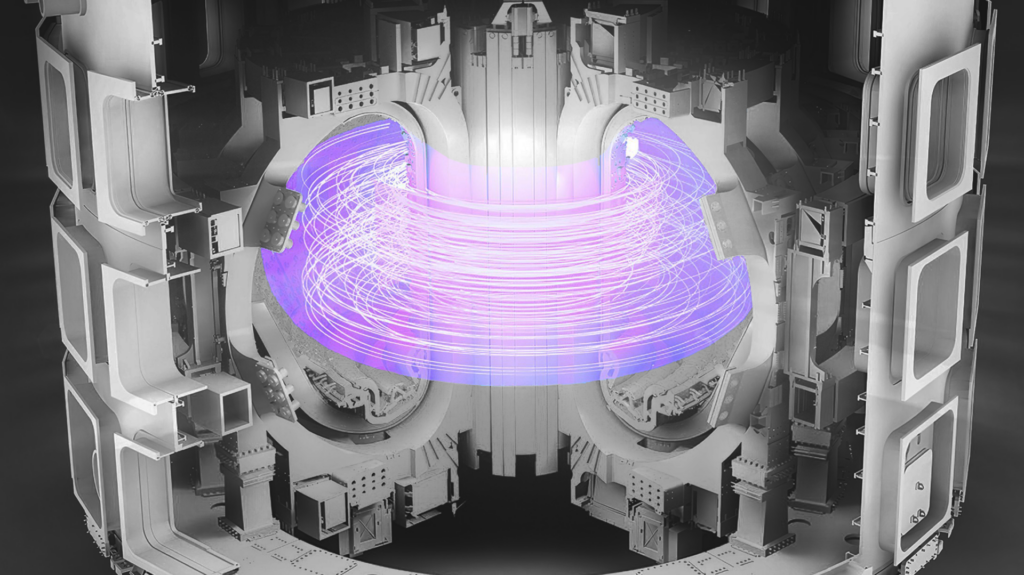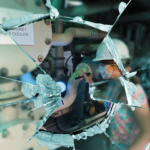What’s fueling the commercial fusion hype?
By Victor Gilinsky | February 20, 2024
 The ITER tokamak will have the world's largest plasma volume of 840 m³. Despite billions of dollars invested over decades, controlled fusion has yet to be demonstrated experimentally and fusion power is nowhere near commercial application. (Credit: ITER International Organization, modified by F. Diaz-Maurin)
The ITER tokamak will have the world's largest plasma volume of 840 m³. Despite billions of dollars invested over decades, controlled fusion has yet to be demonstrated experimentally and fusion power is nowhere near commercial application. (Credit: ITER International Organization, modified by F. Diaz-Maurin)
Recent White House and Energy Department pronouncements on speeding up the “commercialization” of fusion energy are so over the top as to make you wonder about the scientific competence in the upper reaches of the government.
In April 2022, the White House launched what it called a “bold decadal vision” for a 10-year program to “accelerate the realization of commercial fusion energy.” The “bold” part is the proposal, in questionable analogy with high-speed computing, to do in parallel all the development steps that are typically done sequentially to bring a new technology to the market. According to the White House, this parallel processing would include: technology development, preparing a regulatory system (including rules for fusion reactor exports), securing the supply chain, identifying high-value markets, training a diverse workforce, and gaining public support, all “to support the rapid scale-up of fusion energy facilities.”
The special attraction of fusion is of course that it offers a potential source of abundant carbon-free energy that does not generate radioactive nuclear waste. But just because it would be nice if controlled fusion could work doesn’t mean it’s on the verge of doing so. The hard truth is that scientists and engineers don’t even know yet whether controlled fusion can be achieved to make useful work, at least anywhere outside the sun (and other stars, of course).
A historical perspective is useful to understand where the hype about commercial fusion is coming from.
We have known about fusion powering the sun since Hans Bethe explained it in 1939. This was also almost exactly when Otto Hahn and Fritz Strassmann discovered uranium fission (and Lise Meitner and her nephew Otto Frisch explained it). Then in 1942, Enrico Fermi and a small number of co-workers demonstrated a controlled fission chain reaction in a squash court at the University of Chicago. Fermi spent about $50 million in today’s dollars on building his 20-foot-tall atomic pile.
More than 80 years later, the corresponding control-of-fusion principle has yet to be demonstrated experimentally and the US government already made $35 billion in cumulative fusion expenditure—with probably a comparable investment abroad—without yet knowing what works.
The White House’s approach to attain success appears based on the idea that enthusiasm and coordination of all diverse stakeholders backed up with enough money can solve a so-far-unsolved scientific problem. Administration spokespersons mention projects that were successfully accelerated in this way, like the 1969 trip to the moon. Sure, this was indeed a hugely successful monumental project at the time, but no one involved doubted it was possible to do. All the necessary component technologies, like rockets and communications, were in hand on a smaller scale. In the case of fusion power reactors, no one is yet sure what they would look like, let alone if they will turn out to be possible and practicable.
The main research track today in fusion energy is “magnetic confinement”—configuring magnetic fields to keep in place a plasma of thermonuclear fuel 10 times hotter than the sun’s core within a donut-shaped magnetic “bottle.” Dozens of such machines—known as “tokamaks,” a Russian-language transliteration for toroidal chamber with axial magnetic field—have been built around the world since the 1950s, but none got close to demonstrating a net energy gain. Controlled fusion, it turns out, is an extremely difficult problem. To solve it, fusion experts have concluded the key is to have a large enough facility.
The world’s largest experimental fusion machine—ITER (initially the International Thermonuclear Experimental Reactor, also meaning “the way” in Latin)—is nearing completion in France. It is a highly complex scientific and engineering project. ITER publicity describes the building housing the reactor as “slightly taller than the Arc de Triomphe in Paris,” and that the building foundation will support some 400,000 metric tons—“more than the weight of New York’s Empire State Building.” Started in 2006, ITER is a 35-country megaproject that was supposed to be completed in 2016 at a cost of $6 billion. The reactor is currently projected to start up in 2025, but even that appears to be an optimistic date, as is the total budget estimate of about $22 billion.
The initial design objective is to produce a fusion plasma with thermal power 10 times greater than the injected thermal power. Even if successful, this net power output would not yet be the fusion equivalent of Fermi’s 1942 experimental nuclear pile, which proved the controlled fission concept. Nor would ITER’s more ambitious subsequent goal of maintaining this plasma for eight minutes. To get to proof of principle would likely take another step or an upgrading of ITER.
The Lawrence Livermore National Laboratory’s weapons laboratory pursued another approach of “internal confinement,” to create a fusion reaction at its National Ignition Facility (NIF) and claimed it could have power application. NIF uses light pulses from a concentric battery of powerful lasers to heat a small target containing a tiny bead of frozen thermonuclear fuel. This is, in effect, a miniature (secondary) thermonuclear bomb, with the lasers playing the role of the triggering fission reactions (primary). The light heats the container material sufficiently to ablate and swiftly compress the fuel to the point of detonation, which lasts some billionths of a second. The experiment was directed primarily at developing a useful diagnostic tool for weapons research. In power application, you would have to repeat the explosions at an extraordinarily fast rate, which is a tall order.
Despite its lack of promise for civilian use, the Energy Department and the White House have used the Livermore controlled fusion experiment results to boost the effort to harness fusion power for civilian purposes. In December 2022, Energy Secretary Jennifer Granholm announced with great fanfare that a laser pulse ignited a fusion reaction that produced more energy than was supplied by the light beams: “This milestone moves us one significant step closer to the possibility of zero carbon abundant energy powering our society … a huge step forward to the president’s goal of achieving commercial fusion within a decade.” (Update: In less than nine years from now.)
In her energy balance, however, the energy secretary forgot to account for the energy it took to create the laser beams. This energy input, when added, drastically reverses her conclusion, with the fusion output then amounting to only about one percent of the input. This is not disqualifying from a scientific point of view, but it obviously is in a power generating application. Still, this hasn’t stopped the Energy Department from including Livermore’s fusion ignition experiment in a promotional video on the “7 moments that changed nuclear energy history.” The clip claims “[t]he Lab was the first to produce more energy from a fusion reaction than was used to start the process,” again forgetting the energy it took to power the lasers.
Most people in the field still pin their hopes on the international ITER project for advancing the possibility of fusion power. One thing we know already is that, if a magnetic confinement fusion power reactor ever works, it will be huge and expensive. This contrasts with current thinking in energy policy that inclines to a more decentralized electrical system powered by more affordable and flexible generators. With fusion power being so difficult to demonstrate—even in principle—it will likely suffer a much longer time between proof of principle, if we ever get there, and significant commercial application. So, forget the Energy Department’s parallel processing path promise.
A recent White House announcement on fusion had a link to an Atlantic Council discussion on fusion. In it, former Energy Secretary Ernie Moniz, a physicist, said he drew confidence about the prospects of fusion power from knowing that $5 billion of private capital has been invested. This showed him that “somebody must think this has got a good chance of working.” At the same time, if true, the funders who committed the $5 billion were surely drawing confidence from the fusion physicists’ enthusiastic claims. This circular reasoning does make one wonder.
It’s not surprising that the fusion research community at the Energy Department is gushing with enthusiasm for commercialization of fusion and the near-term prospect of building pilot plants and revolutionizing electricity generation. But as with any big-bet investment, some perspective about the possibilities and risks involved is in order. Where is the US government agency that will provide such a perspective?
Together, we make the world safer.
The Bulletin elevates expert voices above the noise. But as an independent nonprofit organization, our operations depend on the support of readers like you. Help us continue to deliver quality journalism that holds leaders accountable. Your support of our work at any level is important. In return, we promise our coverage will be understandable, influential, vigilant, solution-oriented, and fair-minded. Together we can make a difference.
















What about all the privately funded efforts? Perhaps their roadmap claims feel over-optimistic, but many were started via government investment – are they not worthy of mention? In simply focusing on the two biggest publicly-funded fusion bids, this piece feels poorly researched and rather incomplete, and therefore rather a weak argument.
Victor got it wrong in his story about energy output versus energy in. You both need to review the articles better, as the scientific breakthrough was the measurement of output to the amount of energy to start it, not the energy to create the laser beam. Your views are flawed and not of the actual event but poor attempts at misdirection of information and again call into question your qualifications and understanding of your sciences if you do not understand the simple basis of an experiment. You are just trying to pour cold water on an amazing achievement again you… Read more »
No John C, Victor was correct that neglecting the energy input to the lasers was(, in my own words now, dishonest). When the goal is to produce commercial energy, not accounting for the energy input required is misleading, to say the least. I followed the episode carefully, and the hype around the laser zapped pellets was over the top. Granholm’s speech seemed like a funding exercise, preying on the ignorance of those in office. The whole scheme of zapping pellets is a failure at the start. The apparatus and capacitor recharge time is many hours. How can any meaningful CONTINUOUS… Read more »
Gilinsky is correct about the feverish promotion of fusion energy being over-the-top and unjustified. In fact I made a similar protest in a brief essay published in the December 2023 issue of ANS Nuclear News, on p. 6. As Gilinsky notes correctly, magnetic confinement fusion research is far from achieving scientific feasibility, and is stagnating. But inertial confinement is a different story. Here Gilinsky is absolutely wrong about there being no fusion equivalent of Fermi’s Stagg Field experiment in 1942. in fact the demonstration of thermonuclear ignition at Livermore’s laser-driven NIF, plus the shots leading up to that demonstration and its subsequent replication… Read more »
Trying to contain a sustained energy gain reaction seems impossible unless you have something like the SUN, with it’s large mass to compress the hydrogen. How much energy does the magnetic field generation use? I will bet it does no better then the laser ignition system of -99% yield. Then there is the question of where to get the heavy hydrogen and tritium necessary for these systems which may not exists at all in levels necessary for industrial applications. We would be better off going for new design fission plants until an all renewable energy sources can be produced to… Read more »
Thanks, Victor, for this excellent reminder of the difference between hype and fact. But you were (characteristically) overly generous. Except for a few aneutronic reactions with extraordinarily high ignition temperatures, fusion reactors would be free not of “radioactive nuclear waste” but only of fission products and transuranics. Instead, they’d produce awkward amounts of radioactive activation products from structural and containment materials. Fusion’s copious fast-neutron fluxes would also raise serious issues of nuclear weapons proliferation—a threat you have rightly emphasized throughout your distinguished public service. And then there’s the unmentioned fatal flaw: economics. A fusion reactor that works, yields abundant energy,… Read more »
Amory, thanks for your corrections and useful additions. Hope all is well.
Thanks for a great article Victor. Past episodes of hype can be explained in the staging of funding rounds. But the present binge seems to transcend this. And you don’t fully answer: why now? A factor I think is key in this timing is the persistence of military interests in concentrated power production for naval propulsion and directed energy in the same present juncture as run-away collapse in the case for new fission power. This is eroding the longstanding de facto subsidy from civil new-build to the military industrial base. A similar hype is occurring (on a shorter timeframe) around… Read more »
Victor Gilinsky asks an excellent and important question. I believe the answer encompasses two former pillars: 1) The exaggeration about promised net energy and 2) The exaggeration of inexpensive, unlimited, universally available fuel supplies. I have investigated these matters extensively and have written more than 150 news articles about them since 2016. [1] Gilinsky’s article touched lightly on the first pillar when he noticed that U.S. Energy Secretary Jennifer M. Granholm “forgot” to account for the energy consumed by the laser beams when she discussed the energy balance of the National Ignition Facility fusion experiments. This has been the… Read more »
Although Mr. Gilinsky mentions that “tokamak” is a Russian-language transliteration for the toroidal chamber with an axial magnetic field, he forgets to add that Tokamak was first developed by Russian scientists Oleg Lavrentiev, Andrei Sakharov, and Igor Tamm from the Kurchatov Institute of Atomic Energy in the late 1960s, and then adopted around the world. ITER does mention this on their site, but Mr. Gilinsky doesn’t.
Tokomak abbreviation comes from ТОк (Current), КАмера (Chamber), МАгнитная Катушка (Magnetic coil)..
Besides the excellent comments below and Gilinsky’s excellent piece covering the historical perspective, members of this community also have to realize that the AI community has a huge investor in smaller forms of hot fusion, namely Sam Altman (OpenAI CEO) is a huge investor in Helion Energy. That has also brought a lot of visibility to the field of fusion energy in the VC community of silicon valley.
Much of Gilinsky’s article pertains to the subject of Fusion Frenzy- A Recurring Pandemic. That is the title of an article I published in 2021 in the Newsletter of the APS Forum on Physics & Society, Vol. 50, October 2021, pp. 5-9. Here are some paraphrased excerpts of Fusion Frenzy: “Fusion energy fever is a pandemic that once recurred every decade soon followed by disenchantment….. During each pandemic the fever is sustained by self-delusion of the practitioners and by mass psychology—propagandizing the public with the messianic aura of the energy source that powers the sun and stars.” The last great… Read more »
The Livermore results are a significant accomplishment that could provide a data base for fusion weapons research and stockpile stewardship. However, the development of a commercially viable nuclear fusion reactor based on ICF is wishful thinking. “The laser energy delivered to the target was 2.05 MJ, and the fusion output was likely about 3.15 MJ. According to multiple sources on NIF’s website, the input energy to the laser system is somewhere between 384 and 400 MJ. Consuming 400 MJ and producing 3.15 MJ is a net energy loss greater than 99%. For every single unit of fusion energy it produces, NIF burns at minimum… Read more »
The constant use of the fusion process in the sun as an example of a “working” fusion process is an invalid comparison. The sun depends on the quantum mechanics of tunneling. Completely useless for any earth bound fusion energy source. The only successful earth bound fusion process producing copious amounts of energy happens in thermonuclear weapons. NIF uses a process that is similar to, or a subset of, thermonuclear weapons. Pursuing this path is valid. Arguments based on the expense and energy consumption of inertial confinement using lasers are red herrings. If a process actually works then finding cheaper and… Read more »
1 MeV/s = 1.6×10^-19 Mwatt. To get at least 10 Mwatt one has to absorb ionisation-heating from 14.6 MeV neutron flux from DT with 0.43×10^19 1/s. However neutron itself does not produced efficient heating. We need 4pi blanket absorbing all neutrons, where one can potentially get amplification around 5-7 with fission products directly producing ionisation-heat. Neither tokomak, no laser allow to put 4pi blanket. AES today provide many Gwatt 😉
It is dead idea for practical energetics ((
Great article. Please respond with your email so that Chip and I can invite you to an offline discussion.